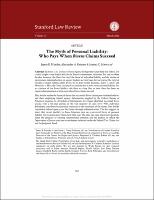Please use this identifier to cite or link to this item:
https://hdl.handle.net/20.500.12202/9921| Title: | The myth of personal liability: Who pays when Bivens claims succeed. |
| Authors: | Reinert, Alexander A. Pfander, J. Schwartz, J. 0000-0002-0258-7656 |
| Keywords: | constitutional remedies Bivens Rule of law Official liability and indemnity Government accountability Empirical legal studies deterrence |
| Issue Date: | 2020 |
| Citation: | Pfander, J., Schwartz, J., & Reinert, A.A. (2020). The myth of personal liability: Who pays when Bivens claims succeed. Stanford Law Review, 72(3), 561. |
| Series/Report no.: | Standford Law Review;72(3) |
| Abstract: | •In Bivens v. Six Unknown Named Agents, 403 U.S. 388 (1971), the Supreme Court held that federal law creates a right to sue federal officials for Fourth Amendment violations. On introducing the Bivens action, the Court described the award of damages for the violation of constitutional rights as a central feature of a liability rule that focused on deterring misconduct by individual officers. But for the last three decades Bivens’ personal liability rule, presumed to directly burden individual officers, has played a central role in the Court’s growing hostility to the Bivens doctrine. During this time, the Court has emphasized the threat of individual liability and the burden of government indemnification on agency budgets as twin bases for narrowing the right of victims to secure redress. In its decision two Terms ago in Ziglar v. Abbasi, the Court said much to confirm that it now views personal liability less as a feature of the Bivens liability rule than as a bug. But, to date, there has been no empirical examination of who pays when Bivens claims succeed. •This Article reports on the first study of its kind to assess the financial threat that successful Bivens claims pose to federal officers and their employing agencies. Information supplied by the Federal Bureau of Prisons in response to a Freedom of Information Act request identified successful Bivens actions over a ten-year period; in the vast majority of cases (over 95%), individual defendants contributed no personal resources to the resolution of the claims. Nor did the responsible federal agency pay the claims through indemnification. The data suggest, in short, that recent hostility to Bivens litigation rests on a perceived threat of personal liability that is much more theoretical than real. The data also raise important questions about the adequacy of existing constitutional remedies and the manner in which the Department of Justice exercises its settlement authority under the Federal Tort Claims Act and the Judgment Fund. |
| Description: | Scholarly article / Open access |
| URI: | https://papers.ssrn.com/sol3/papers.cfm?abstract_id=3343800 https://hdl.handle.net/20.500.12202/9921 |
| ISSN: | 0038-9765 |
| Appears in Collections: | Benjamin N. Cardozo School of Law: Faculty Publications |
Files in This Item:
| File | Description | Size | Format | |
|---|---|---|---|---|
| Reinter 2020 OA The myth of personal liability.pdf | 858.75 kB | Adobe PDF |  View/Open |
This item is licensed under a Creative Commons License

